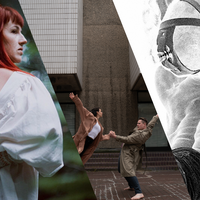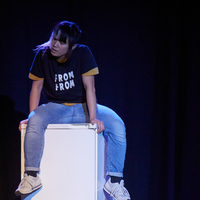Sat 3 Feb: Jasmin Saulo & TNG:HE , JAMEYWAMEY, Fabio Pronesti

News Story
Jasmin Saulo & TNG:HE La Na
JAMEYWAMEY A Tribute to Ólafur
It felt wrong to have seen La Na for free. Jasmin Saulo’s skilfully structured, tai-chi-inspired choreography saw more than 20 men smoothly ricochet off each other as strong, staccato movement abruptly transformed into slow-motion to the beat of the performers’ breath. Below the surface of this powerful work, individuals cried out, struggling to accept help from a friend or unable to keep up with this overt show of masculinity. I hope we continue to see dance explore
men’s mental health, as well as future creations from the brilliant TNG:HE.
“This song is called ‘Unfold’". The pianist addresses his audience on the recording, immediately transporting us to a New York piano bar. As the second of three acts commences, dance artist (never has the term been more apt) JameyWamey continues his semi-improvised exploration of fluid body popping, every inflection in the music perfectly mirrored by a twinged muscle, flexed back or twisted knee. It’s like watching videos of liquid bubbling after being placed over a speaker. Gradually, the movement becomes more laboured, the music forcing him on as he heads towards the floor. It’s a subtle tonal shift, but bolder dynamics would have helped A Tribute to Ólafur hold on to its hypnotised audience.
As Fabio Pronesti strolls the stage to jaunty Italian music, it’s like watching a black-comedy villain leaving a crime scene to Sophie Ellis-Bextor. This multi-act work is unnerving, with matches lit to a multi- lingual monologue and a finale featuring water being poured into an overflowing glass. Pronesti has a calm confidence, assured his audience will hang on to every beat of this quiet chaos stitched together with dance-breaks that swing between repeated phrases of reaching, running and crawling, constantly changing tempo and fascinated with his hands. Alas, one too many ideas meant Souvenir felt disjointed and, consequently, any meaning behind the otherwise impactful watery ending was lost in translation.
Beatrice Thomas
With its company of twenty plus dancers, La Na is immediately striking. Equally impactful is the careful crafting by Jasmine Saulo and TNG:HE of this extensive and highly physical work, met brilliantly by the skill and strength of every performer on stage. There are moments of tightly crafted unison, solos, duets and trios that splinter from the group, and lifts timed to catch the eye among a sea of motion. An acutely choreographed use of breath creates unity between its dancers, highlighting rhythms and accenting the company’s movements with powerful sharpness. Defined by a strong, fluid and athletic physicality, La Na explores a journey of healing and, with each dancer fully invested in their performance, the company shapes a powerful and dramatic work; whether that’s in moments of explosive physicality, or soft dips into quietness.
JameyWamey’s improvised solo A Tribute to Olafur is a last minute revision to the evening’s programme. It’s an introspective piece and, while JameyWamey appears absorbed in his world as he dances, his gaze rarely meeting the audience, you equally feel welcomed to experience this moment with him. JameyWamey is easy to watch, his physicality absorbing. Across three improvisations, his soft, articulated movement develops in response to each track, his body folding and unfolding as if his very bones are liquid. The accompanying piano tracks, a recording that includes the composer in conversation with his audience, offer a fitting parallel. It’s a physically beautiful and sensitive solo to witness, though some variation in structure or in the improvised responses would elevate this piece.
Fabio Pronesti strikes a match and stares nonchalantly at the audience; an action simultaneously direct and casual. As Souvenir unfolds, Pronesti’s performance echoes that tone. His movements are minimal and decisive, the choreography embodying a relaxed, almost functional quality that feels at one with this work.
In a potentially fitting structure for a piece about retracing memories, scenes in Souvenirplay out then disappear. Each episode is intriguing but unlinked, leaving a sense of disconnect and uncertainty towards what is happening on stage. It’s a strong work and the images Pronesti creates have clarity, yet like our memories, Souvenir gets a little lost in its own abstractness.
Rachel Elderkin


